The CC-40


| Size: | 9.5"x5.75"x1" |
| Weight: | 22 oz. |
| CPU: | TMS70C20 CMOS 8 Bit |
| Speed: | 2.5 MHz |
| ROM: | 34K |
| RAM: | 6-18K |
| Display: | 31 character 5-by-8 dot matrix Liquid Crystal Display |
| Power Supply: | Four AA batteries or AC Adapter |
| Manufactured: | 1983 |
This is the Texas Instruments Compact Computer 40, or CC40. The keyboard is composed of 'chicklet' style keys. In addition to a traditional QWERTY-style keyboard, there is a numeric keypad to the right. Four special keys are located above the keypad: BREAK, RUN, ON, OFF. A recessed reset button is located to the right of the space bar.
The screen is a LCD and is one line by 31 characters long. Display contrast is adjusted by a dial which is located on the left side of the machine. Special characters are also located on the display: SHFT, CTL, FN, DEG, RAD, GRAD, I/O, UCL, ERROR, a low battery indicator, left and right arrows to indicate that text had scrolled off the screen, and six arrow-shaped indicators that can be turned off and on by the user through the use of the 'CALL INDIC' command. Although fairly simple as graphics, custom characters can be defined. Using the 'CALL CHAR' command, the dots in 5-by-8 grids can be specified as being 'on' or 'off'.
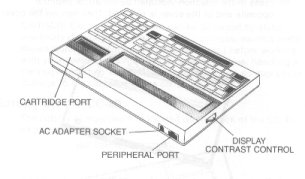
A cartridge
port is located on the upper right corner of the machine. Memory could
be expanded by installing a cartridge or 'preprogrammed Solid State
Software' cartridges could be used. Titles released by Texas
Instruments included: Memo Processor, Mathmatics, Games #1, Finance,
and Electrical Engineering. 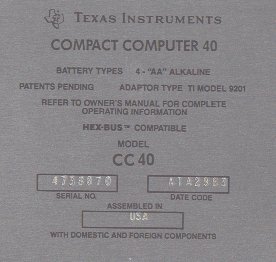
This is the back of my CC40. As you can see, it operates on two 'AA' batteries or an optional AC power adapter. The power adapter (TI model 9201) is plugged into a jack in the rear left corner of the machine. The CC40 has an automatic power down feature which will be activated after approximately ten minutes of no input. Even when turned off, the 'constant memory' feature will retain programs stored in memory.
The CC40 is
composed of two double-sided circuit boards connected
to one another by two ribbon cables (yellow- shown below).
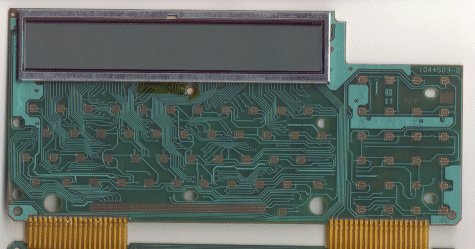
This is the
'top' circuit board. A rubber pad sits between each of the keys and the
coresponding contacts on the circuit board. The pad creates the 'spring
back' response of the keys as well as serves to make contact between
the lines on the board.
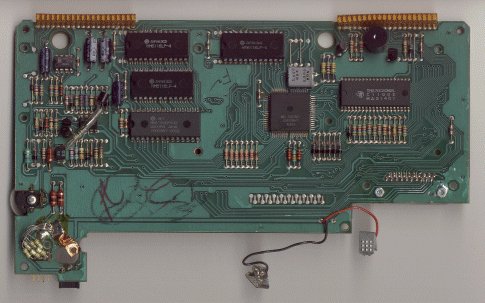
This is the 'bottom' circuit board. The IC's (left to right by column) are as follows:
HM6116LP-4
HM6116LP-4
HN61256PC09
HM6116LP-4
I041036-1
TMX70C20N2L
(As near as I can tell.)
Photos From The
CC40 Box:

Caption Reads:
"Printer/Plotter prints standard characters and full graphics in four
colors."
Powered by batteries.
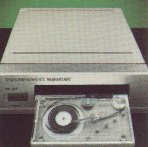
Caption: "Wafertape [tm] digital tape drive- fast and reliable mass
storage."
On my box, a sticker below that caption states: "Wafertape digital tape
drive is not available." Reportedly, the wafertape drive was not
reliable and it was therefore never put into production. No other form
of mass storage device was ever made for the CC40- a major pitfall.

A CC-40 system. Stacked on the right (top to bottom): Printer/Plotter,
Wafertape Digital Tape Drive, RS232/Parallel Interface.
Regarding the
RS232, the box reads: "An RS232/Parallel Interface- To Talk With The
World. An RS232/Parallel interface allows you to connect the CC-40 with
most 80-column printers and X-Y plotters. By adding a telephone coupler
(modem), you can communicate with computers and information nets across
the world."

I purchased this book off the internet. It's titled Learn Basic: A Guide to Programming The Texas Instruments Compact Computer 40 by David Thomas and Texas Instruments. The back cover states that Mr. Thomas was a writing consultant to TI. According to the 1983 copyright, the book was published by McGraw-Hill and Texas Instruments.
Composed of 28
'lessons' it apparently assumes no previous knowledge of BASIC
programming and begins with variables and moves through to string
manipulations and logical operations.
- Download this book
from the file database: Guide
To Programming The CC40
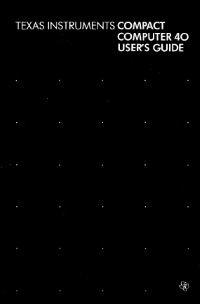
The CC40 was shipped with a user's guide that lists the lists the CC40 specs, and explains how to program it.
- Download this book from the file database: CC40 User's Guide
This file has been in the database since 2006, but on 7/10/15, I uploaded a 'cleaned up' version.
Own a CC40! Mike Dudeck sells CC40 computers and equipment, and has sent me a new price list. You can take a look at his inventory by visiting www.texintreasures.com or you can contact Mike at [email protected]
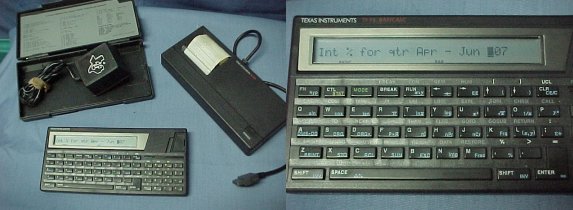
You can type these Basic programs into your CC40:
CC40:
CC40 Files In The 99er File Database
Purchase A CC40 From Tex*In Treasures
Old-Computers.com
TI-74:
The Pocket Computer Museum
High
Tech Solutions
Something to contribute? Questions? Comments? Corrections? E-mail me at [email protected]
Texas
Instruments, TI, TI-99/4A, CC40, Wafertape, Solid State Software, and
Constant Memory are all trademarks or service marks of Texas
Instruments Inc.
Items on this non-commercial site are presented for reference/nostalgia purposes only.
� 2015 [email protected]